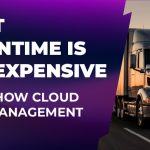We live in an increasingly digital world, and the demand for cost-effective and modern transportation solutions is constantly evolving and growing. This has led to a continuing evolution in solutions, new business models, and the emergence of new players in the industry. The mobility services market is projected to grow from USD 524.0 Billion in 2016 to more than USD 3.1 Trillion by 2025. The advent of transport services and the increasing adoption of fleet management solutions have led to an exponential increase in companies operating as mobility service providers.
The trucking sector has benefited from advances in GPS fleet tracking. Even though GPS tracking has been around for a long time, the Internet of Things and connected gadgets have boosted the effectiveness of tracking systems. In particular, the trucking industry.
Fleet managers can track all of their vehicles in real-time using GPS. To improve operations, look back at previous location records. Also, to boost efficiency and profitability, use numerous data points and crucial insights. This article will discuss some of the benefits of using GPS tracking and geofencing solutions in your company’s fleet management process.
What is GPS tracking?
The global positioning system, also known as GPS, is a global radio-navigation satellite system. It allows you to track your drivers and vehicles from a distance.
The system uses a transmitter within a phone or a navigation device. It sends out a signal picked up by several satellites in orbit. GPS fleet tracking can assist in streamlining operations and increase efficiency. It essentially makes drivers’ and fleet managers’ lives easier.
Here are some of the most significant advantages of using a GPS and geofencing:
1. Intelligent route planning
By examining details of previous travels using the position history map, GPS fleet tracking may also help determine the best and worst highways. Fleet managers can spot congested roadways and optimize routes with location-based historical data.
Route optimization can help drivers become more efficient and productive.
2. Prevent the usage of unauthorized vehicles.
Fleet managers may immediately discover if a vehicle is being utilized for personal or side jobs using real-time GPS tracking and location history information.
3. Theft prevention for cargo
In 2018, 592 cargo thefts totaling $142,342 were reported in the United States.
Vehicle and container theft can be thwarted using GPS tracking and virtual geofenced parameters. All cars may be tracked in real-time by fleet management. If a vehicle deviates from its intended path, take immediate action.
4. Administrative burden reduced
Fleet managers may reduce the administrative load by eliminating laborious paperwork and reducing phone calls to drivers.
A fleet administrator may acquire real-time updates by glancing at their fleet management dashboard.
5. Real-time automated alerts
Because GPS tracking allows fleet managers to watch cars in real-time, they may use virtual parameters to create geofenced alerts whenever a vehicle enters or exits a job site.
When you don’t have to track your vehicles manually, you can more efficiently organize your operations and everyday activities. Knowing where all of your cars are and receiving automated notifications when they enter or exit key locations can help you save time and effort.
For example, informing clients of delays is a significant GPS tracking benefit. Similarly, fleet managers can send geofenced notifications to shippers or recipients. If drivers are about to arrive at the site, that is. Processes can be sped up, and early notifications can reduce productivity and detention time.
6. Usage-based invoicing
You may use GPS tracking to determine where your vehicles and assets are and how long they’ve been there. This is particularly advantageous for the oil and gas industries. They are invoicing and being paid to require accurate time-on-site calculations.
Fleet administrators can manage billing, invoicing, and payroll with location-based data.
7. Increased productivity
Another advantage of GPS tracking is that you may improve your competitiveness by comparing performance against delivery service level agreements. A service-level agreement (SLA) lays out the measurements and defines the degree of service you anticipate from a vendor. If the service level is not met, it also contains remedies or fines.
If your SLA states that you will deliver an item by 10 a.m., you can use GPS to confirm that you arrived on time.
8. Reduced detention time
Fleets can spend up to $1,280 per driver per year for detention time. Furthermore, a DAT survey found that only 3% of drivers receive detention fees for nearly 90% of their claims to shippers.
As a result, using GPS tracking and geofencing to decrease the potential of detention time is critical.
You can determine when a driver enters and exits a facility using real-time vehicle tracking and automated geofencing warnings. This data can assist you in identifying inefficient shippers and receivers who hold drivers for excessively long periods.
Motive customers can also access Facility Insights, which provides detailed warehouse data. This includes peak hours and average dwell time.
9. Reduced fuel consumption
According to a 2018 ATRI analysis, trucking’s operational costs climbed 7.7% from 2017. Fuel prices grew the most year over year of all the primary forms of operating expenditures—a 17.7 percent increase.
For most fleets, fuel is one of the most expensive operational expenses. Fleet managers can focus on profitability by optimizing fuel usage and reducing waste.
With GPS tracking and historical reports, fleet managers can compare multiple routes. Determine how much fuel each course consumes. To save money on gas, choose the most efficient way.
You may save operational costs by having more visibility into operations, location history, and more innovative route planning.
10. Improved customer service
GPS car tracking and real-time vehicle location data can help you improve customer service and gain a competitive advantage.
You can provide precise predicted arrival times to your consumers if you know exactly how far away your cars are from their location.
With GPS tracking, you can increase productivity and profitability.
If you operate a truck, bus, or another vehicle for business purposes, you can use GPS tracking to keep track of it. You can use the tracking data to ensure that the vehicle is where it’s supposed to be when it’s supposed to be there. This can help boost productivity and profitability. GPS tracking can also be used to monitor the status of assets. If something is wrong with a purchase, you can keep an eye on it to maintain it properly. This can help increase profitability.
The built-in GPS tracking system in the TMS-Digital fleet management solution allows fleet managers to observe each driver’s real-time whereabouts on an interactive map. Additionally, fleet managers can monitor any driver’s or vehicle’s location history to see where they were at any given time. And not only GPS tracking and geofencing, but TMS-Digital also offers a suite of features from dispatch to IFTA and is cyber secure. Contact us today for a demo and begin the journey towards productivity and efficiency.




